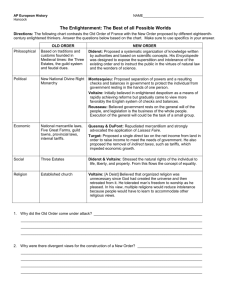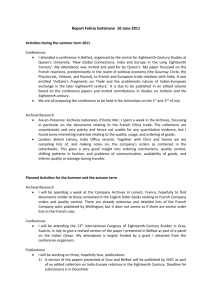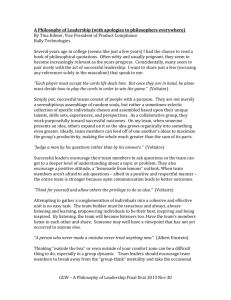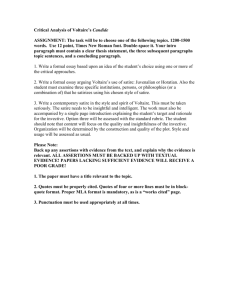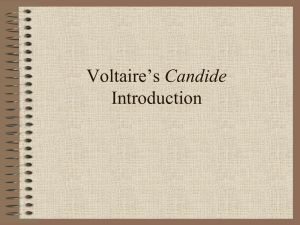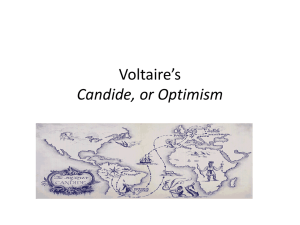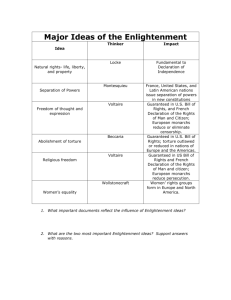Style Guide - Voltaire Foundation
advertisement
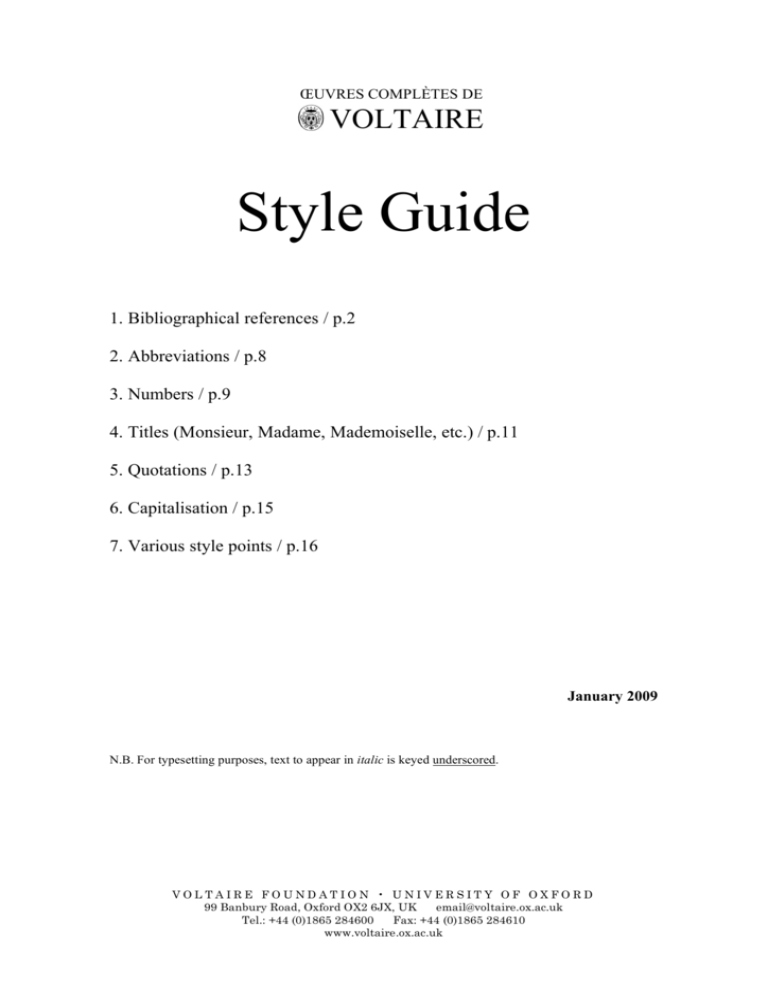
ŒUVRES COMPLÈTES DE VOLTAIRE Style Guide 1. Bibliographical references / p.2 2. Abbreviations / p.8 3. Numbers / p.9 4. Titles (Monsieur, Madame, Mademoiselle, etc.) / p.11 5. Quotations / p.13 6. Capitalisation / p.15 7. Various style points / p.16 January 2009 N.B. For typesetting purposes, text to appear in italic is keyed underscored. VOLTAIRE FOUNDATION • UNIVERSITY OF OXFORD 99 Banbury Road, Oxford OX2 6JX, UK email@voltaire.ox.ac.uk Tel.: +44 (0)1865 284600 Fax: +44 (0)1865 284610 www.voltaire.ox.ac.uk STYLE GUIDE • ŒUVRES COMPLÈTES DE VOLTAIRE 1. Bibliographical references The full citation is given in a footnote on the first occasion that a book is cited. For subsequent citations, the shortened form is used. Check that bibliographical details given in notes correspond exactly to those given in the List of works cited. Full citation for a book N.B. a comma should be added after the place of publication: this is a change to our house style. French: Louis Moréri, Le Grand Dictionnaire historique, ou le mélange curieux de l’histoire sacrée et profane, 5 vol. (Amsterdam, 1740, BV2523), t.2, p.231. [Note that it is usual in French to use ‘5 vol.’ and ‘t.2’ in a single reference.] English: Louis Moréri, Le Grand Dictionnaire historique, ou le mélange curieux de l’histoire sacrée et profane, 5 vol. (Amsterdam, 1740, BV2523), vol.2, p.231. Shortened form The shortened form contains the author’s surname, a shortened form of the book title (usually containing the initial word or words of the full title), volume number (if more than one volume), and page number. In French editions, it also includes the author’s (if living) initial. French: Moréri, Le Grand Dictionnaire historique, t.2, p.231. English: Moréri, Le Grand Dictionnaire historique, vol.2, p.231. Latin terms (Op. cit., loc. cit., etc) are not used. ‘Cf.’ can be used, however, but only when signalling a contrasting point of view, not when ‘See/Voir’ is meant. Full citation for an article in a book or journal French: Christophe Martin, ‘De quelques ressemblances imaginaires dans l’œuvre de Marivaux’, dans Marivaux et l’imagination: actes du colloque de Toulouse, éd. F. Gevrey (Toulouse, 2002), p.89-104. English: Christophe Martin, ‘De quelques ressemblances imaginaires dans l’œuvre de Marivaux’, in Marivaux et l’imagination: actes du colloque de Toulouse, ed. F. Gevrey (Toulouse, 2002), p.89-104. 2 STYLE GUIDE • ŒUVRES COMPLÈTES DE VOLTAIRE N.B. – only the first word of a journal or book article title takes a capital letter (even if that word is the indefinite or definite article). – where a specific page is referred to, the citation should include the full page range and the page referred to in parentheses: Christophe Martin, ‘De quelques ressemblances imaginaires dans l’œuvre de Marivaux’, in Marivaux et l’imagination: actes du colloque de Toulouse, ed. F. Gevrey (Toulouse, 2002), p.89-104 (p.93). Shortened form French: C. Martin, ‘De quelques ressemblances imaginaires dans l’œuvre de Marivaux’, p.93. English: Martin, ‘De quelques ressemblances imaginaires dans l’œuvre de Marivaux’, p.93. Full citation for an article in a journal Béatrice Didier, ‘Lieux et espace dans La Vie de Marianne’, Stanford French Review 11 (1987), p.33-50. Shortened form (French): B. Didier, ‘Lieux et espace dans La Vie de Marianne’, p.33-50. Œuvres complètes de Voltaire (OCV) Although details about OCV appear in the list of abbreviations in the preliminaries of each volume, the following information should be given in the first citation and following citations: Full citation French: La Henriade, OCV, t.2, p.453. English: La Henriade, OCV, vol.2, p.453. 3 STYLE GUIDE • ŒUVRES COMPLÈTES DE VOLTAIRE Shortened form: French: OCV, t.2, p.453. English: OCV, vol.2, p.453. Correspondence and related documents As the full bibliographical details of this appear in the list of abbreviations in the preliminaries of each volume, only the shortened form is required: D2588. Dictionnaire philosophique The first reference to an article in the Dictionnaire philosophique should take this form: Dictionnaire philosophique, article ‘Gloire’, OCV, t.36, p.175. Further references to the same article which immediately follow the previous reference take the form: ‘Gloire’, p.307. If frequently cited, Dictionnaire philosophique is added to the list of abbreviations as DP, e.g.: voir l’article ‘Amour’ du DP (OCV, t.35, p.24). Questions sur l’Encyclopédie References to articles in the same or earlier OCV volumes of the work take the form: Same volume: As line numbers are not known until after typesetting, editors should supply references in the form: Voir ci-dessus, l’article ‘Académie’, lignes 00-00<999>. Earlier volume: QE, article ‘Académie’, OCV, t.38, p.47. Later volume: QE, article ‘François Xavier’, M [i.e. Moland edition], t.26, p.218. 4 STYLE GUIDE • ŒUVRES COMPLÈTES DE VOLTAIRE In other OCV volumes: Questions sur l’Encyclopédie, article ‘Académie’, OCV, t.38, p.47. If frequently cited, Questions sur l’Encyclopédie is added to the list of abbreviations as QE, otherwise Questions sur l’Encyclopédie is given in full. Essai sur les mœurs Citations should be from OCV where possible. Same volume: Voir ci-dessous, ch.12, [+ ‘chapter title’, if helpful] lignes 00-00<999>. Earlier volume: EM, ch.12, OCV, t.22, p.21. Later volume: Citations from sections of the Essai as yet unpublished in OCV should refer to the edition by René Pomeau (Essai sur les mœurs, ed. René Pomeau, 2 vol., Paris, 1990). As this edition will appear in the list of abbreviations in the preliminaries of each volume of the Essai, it should be cited as follows: EM, éd. Pomeau, t.2, ch.12. Voltaire en son temps This work will be listed as follows in the list of abbreviations in the preliminaries of each volume of OCV: English: VST René Pomeau and others, Voltaire en son temps, 2nd ed., 2 vol. (Oxford, 1995) French: VST René Pomeau et autres, Voltaire en son temps, 2e éd., 2 vol. (Oxford, 1995) All citations are to be given from/converted to this, the second edition. To cite in running text: and René Vaillot, in ‘Avec Madame Du Châtelet’, argues that ‘[...]’.15 5 STYLE GUIDE • ŒUVRES COMPLÈTES DE VOLTAIRE Footnote reference: English: 15 VST, vol.1, p.434. French: 15 VST, t.1, p.434. N.B. The author’s name is not cited in the footnote reference. Names of authors of individual sections, for citing, if necessary, in running text: Volume 1: P.1-273 P.275-612 P.613-907 Volume 2: P.1-352 P.353-665 René Pomeau [‘D’Arouet à Voltaire’] René Vaillot [‘Avec Madame Du Châtelet’] René Pomeau, Christiane Mervaud and others [‘De la cour au jardin’] René Pomeau and others [‘Ecraser l’infâme’] René Pomeau and others [‘On a voulu l’enterrer’] SVEC The numbering of SVEC (Studies on Voltaire and the eighteenth century) changed in the year 2000, leaving us with two ways of citing its issue numbers. Old-style SVEC Full citation: Michael E. Hobart, ‘The analytical vision and organisation of knowledge in the Encyclopédie’, SVEC 327 (1995), p.153-82 (p.165). Shortened form: Hobart, ‘The analytical vision and organisation of knowledge’, p.167. New-style SVEC Full citation: Thomas Wynn, ‘Decoration and imagination in four eighteenth-century adaptations of Gerusalemme liberta and the Tancrède legend’, SVEC 2004:07, p.275-93 (p.283). Shortened form: Wynn, ‘Decoration and imagination’, p.280. 6 STYLE GUIDE • ŒUVRES COMPLÈTES DE VOLTAIRE Moland As the full bibliographical details of this appear in the list of abbreviations in the preliminaries of each volume, only a shortened form is required: M, vol.27, p.345 (N.B. This has changed from M.xxvii.345 in order to accord with our general principle of citing volume numbers in arabic). Please check the frequently updated ‘List of published texts’ on our website (www.voltaire.ox.ac.uk/complete_works) to see which of Voltaire’s works have now been published in our edition of the Œuvres complètes de Voltaire. For any texts that we have published, please cite our edition rather than the Moland edition. Miscellaneous References to classical texts normally take the form I.ii.3. Avoid repetitious use of ‘book’, ‘part’ if possible. For eighteenth-century works, give the place of publication indicated on the title page, followed, if necessary, by the actual place of publication within square brackets, e.g. (Londres [La Haye]). The place of publication is normally given in the language of the running text. American place of publication should include an abbreviation of the state (see attached list, ‘Abbreviations of American states’). Original and modern dates of publication can be placed together in one set of parentheses separated by a semi-colon: Fénelon, Les Aventures de Télémaque (1699; Paris, 1987) or if it is an edited text, the dates are separated either side of the editor’s name: Robert Chasles, Les Illustres Françaises (1713), 2nd ed., ed. Frédéric Deloffre (Paris, 1967). The publisher is not normally given for post-1800 texts. 7 STYLE GUIDE • ŒUVRES COMPLÈTES DE VOLTAIRE 2. Abbreviations These are the only terms which we abbreviate: Term chapter(s) circa column(s) Edited by Edition folio(s) manuscript(s) nota bene note(s) page(s) paragraph recto Saint signature(s) tome(s) translated by verso volume(s) English editions ch. c. col. Ed. ed. f. ms. N.B. n. p. § r St sig. – trans. v vol. § French editions ch. vers col. éd. éd. f. ms. N.B. n. p. § r saint sig. t. trad. v vol. / t. § The following English terms are never abbreviated: act, appendix, article, book, canto, figure, index, introduction, letter, line, part, plate, preface, psalm, scene, section, stanza, verse The following French terms are never abbreviated: acte, alinéa, annexe, appendice, article, avant-propos, chant, figure, index, introduction, lettre, ligne, livre, partie, préface, planche, psaume, scène, section, strophe, vers, verset 8 STYLE GUIDE • ŒUVRES COMPLÈTES DE VOLTAIRE 3. Numbers Arabic versus Roman numerals In running text all references of the following sorts should use arabic numbers: act 4, appendix 2, book 3, canto 24 (canto 24, line 3), chapter 4, epistle 7, figure 4, folio 26, folios 34-45, letter 23 (e.g. ‘in the Lettres philosophiques, letter 23, Voltaire declares:’), line 14, part 2, page 27, plate 4, psalm 24, section 9, verse 16, volume 5. Word and number should be joined by a non-breaking space (alt+space or ctrl+cap+space). In footnote references our accepted abbreviations should be used: f.5, etc. Roman numerals are used only in the following instances: (a) kings and queens: Upper case roman numerals are used to designate kings and queens, e.g. Henry VIII, François Ier. A non-breaking space (alt+space or ctrl+cap+space) must be used between name and roman numeral; (b) short references to plays or long poems: Roman numerals are used to indicate where a quotation is taken from in a play, or a long poem with sections. For a play this takes the form: V.iii.234 (act number, upper-case roman; scene number, lower-case roman; line number, arabic). However, in running text or captions (or where the use of roman numerals is redundant), arabic numbers should be used: ‘act 5’, ‘scene 3’, ‘line 234’, ‘canto 3’, ‘book 2’; (c) years of the French revolutionary calendar: an IV; (d) preliminary pages are numbered in lower-case roman numerals. A reference to a preliminary page takes the form: ‘voir p.xxiii’. Roman: small capitals: used only in sigla in the editions section: W75G N.B. References to books of the Bible are now given in arabic numbers. Chapter and verse are divided by a colon, with no space. For example, John 12:16; Psaumes 2:23. Miscellaneous Where the word ‘number’/‘numéro’ is abbreviated, the following applies: English: no.3; no.3, 4, 5 French: no 3; nos 3, 4, 5 References to centuries should be written in full: e.g. ‘qui régna au huitième siècle’, not ‘qui régna au VIIIe siècle’. This should also be incorporated into the modernisation of Voltaire’s own texts, and signalled in the principles of the edition section. Numbers up to 100 should be spelt out unless given together with a unit or as part of a list, e.g. 20 per cent, 10 inches, 22g; ‘he had acquired 79 sheep, 108 cows and 10 pigs’. 9 STYLE GUIDE • ŒUVRES COMPLÈTES DE VOLTAIRE Spell out ‘million’: 20 million. Omit commas in numbers up to 9999. Elide numbers, including variant line numbers, over 100 to two figures: 257-58, except where the second figure would start with 0, e.g. 202-203. 10 STYLE GUIDE • ŒUVRES COMPLÈTES DE VOLTAIRE 4. Titles (Monsieur, Madame, Mademoiselle) The French deal with these titles differently in different contexts. As far as OCV is concerned, there are three main areas in which different forms might be used: - ordinary prose (section 2) - dialogues, plays or reported speech (section 3) - titles of books or works (section 9) There are, in addition, certain special cases, such as historical titles (section 7). 1. abbreviation M. (MM.) Mme (Mmes) Mlle (Mlles) Mgr (Mgrs in preference to NN. SS.) 2. when you are discussing a person (N.B. new style change) Abbreviation. Initial capital. Voltaire a rencontré Mme Dupont j’attends M. le marquis M. le baron va vous recevoir M. le président viendra il rencontra M. le cardinal de Polignac 3. when you are addressing a person No abbreviation. No initial capital. j’écoute, monsieur Duval monsieur le directeur, permettez-moi de vous présenter M. Dupont oui, monsieur non, monsieur le président oui, monseigneur 4. addressing a person in a letter No abbreviation. Initial capital. Chère Madame, Je vous prie de croire, Monsieur, à l’expression... Alors, à bientôt, Madame Ménard, le plaisir... Veuillez agréer, Monsieur le Directeur, l’expression... 11 STYLE GUIDE • ŒUVRES COMPLÈTES DE VOLTAIRE 5. polite constructions No abbreviation. No initial capital. je vais voir si madame peut recevoir mademoiselle monsieur prie madame de l’attendre au salon 6. when the proper name is replaced by a common noun No abbreviation. No initial capital. j’ai rencontré madame votre mère hier après-midi il s’occupera de monsieur votre fils (N.B. ‘mère’ and ‘fils’ are considered common nouns, while ‘président’, ‘maire’ etc. are part of civil titles, and come under section 2) 7. historical titles No abbreviation. Initial capital. Monsieur (frère du roi) Monsieur le Prince (Condé) Madame Madame Royale la Grande Mademoiselle Monsieur de Paris Monsieur le Duc 8. a proper name denoting a characteristic: No abbreviation. Initial capital. une Madame Bovary qui s’ignore un Monsieur Jourdain de la finance 9. the titles of books or works: No abbreviation. Initial capital. Madame Bovary Sur ‘L’Anti-Lucrèce’ de Monsieur le cardinal de Polignac 10. The common noun No abbreviation. No initial capital. j’ai vu ces messieurs 12 STYLE GUIDE • ŒUVRES COMPLÈTES DE VOLTAIRE 5. Quotations Please check that all quoted matter can be traced back to its source. Give full reference in the first instance and shortened ones for subsequent references (see above for preferred style for bibliographical references). If two short references occur close together they can be combined in one note. Run on quotations Short quotations of prose (up to 65 words) should be run on in the text within single quotation marks (unless two or more short quotes are to be deliberately displayed in order to facilitate comparison). We avoid giving references for short quotations in the text, and give these instead in a footnote. ‘Le plus grand génie […]: y en-a-t-il dont on doive se priver?’3 3 OCV, vol.14, p.109-10. His openness to all the beaux-arts notwithstanding, Voltaire was no musician… Display quotations Prose quotations of 65 or more words should be displayed, that is begun on a new line, without quotation marks, using the tags <q> before the first word and </q> following the last word of the quotation. … alluding to the fact that the duc has already had the divertissement from act 2 for a week (D2964): <q>Colletet envoie encore ce brimborion au cardinal duc […] C’est à vous et à messieurs les généraux à me fournir à présent le prologue.</q> It is clear that the subject-matter is already decided… Verse quotations of two or more lines should be displayed, with a hard return at the end of each line. (The layout of the original should be closely followed, including all indentations indicating metrical patterns.) Insert the tags <q><v>, <em> and </v></q> as follows: <q><v>A, V, G, R, C, G, cette énigme me gêne, Je veux la deviner avant la fin du jour; <em>Ah! je n’aurai pas grande peine, <em>Le mot de l’énigme est amour.</v></q> 13 STYLE GUIDE • ŒUVRES COMPLÈTES DE VOLTAIRE Short references in parentheses are normally positioned before a colon introducing the displayed quoted matter. If the quotation ends with a note cue, the reference should be cited in the note. Quotations in notes Quotations in notes should not be displayed line for line. Lines of poetry in notes should be separated by spaced, oblique strokes and enclosed within single quotation marks. References are given in parentheses; commas are used to separate items usually given within parentheses: (Dorrit Cohn, Transparent minds, Princeton, NJ, 1978, p.145-61). The following rules should normally be applied to quoted matter: (a) State if the italic is not in the original but has been added for emphasis. (b) ‘[sic]’ is discouraged when used to indicate obvious misprints or the idiosyncratic spelling of proper names. If it is used to indicate an otherwise unobvious error that is not central to the purpose of the quotation it is better to give the correction within square brackets: ‘John Smith, [arch]bishop of Canterbury’. (c) Works in French or English are quoted in the original language unless the translation itself is under discussion. Quotations from works in other languages should be accompanied by a translation in a footnote. (d) Square brackets should be used for editorial interventions. 14 STYLE GUIDE • ŒUVRES COMPLÈTES DE VOLTAIRE 6. Capitalisation Capitalisation of titles In the titles of printed works capitalisation is limited to the first letter of the first word of the title (in addition to the article, if present) and proper nouns (The History of England; A Tale of woe; Essays on various subjects). If the first word of a French title is an article, the following noun and any preceding adjectives also take an initial capital: Les Petits Riens. Capitalisation of names Capitals are not used in hereditary and ecclesiastical English titles unless directly followed by the holder’s name: the king of England or the king, but King George or George II (N.B. ‘King’ is not needed with ordinal); the bishop of Matabeleland but Bishop Smith; the duke of York, but Duke Richard. Use capitals for the names of characters, where appropriate: the Old Man, the Nephew, the Vicar, Le Loup et l’Agneau. Epithets closely linked with the name, or phrases which replace the name, should be capitalised: Frederick the Great, le Roi Soleil. French compound names should have all elements capitalised with the exception of de and d’: Marc-Antoine René d’Argenson but Mme Du Deffand and Mme Du Châtelet. Exceptions to this rule are D’Alembert (because it is not a noble particle) and the duchesse du Maine (because it is a title, not a name). French personal titles appear with lower case initials, unless abbreviated: M. Legrand, Mme de Genlis, abbé, comte, duc, père. N.B. ‘Père’ is capitalised when it refers to a Church father. Capitalisation of occupational titles The names of posts such as professor, lecturer, councillor, judge and so on do not take capitals unless: directly followed by holder’s name: Councillor Jones (but Mr Jones, Oxford councillor); Judge Jeffries (but Jeffries, a high court judge); Professor Pooter. they are formal titles (often job name plus another name): the Mitsubishi Professor of Engineering (but he was professor of engineering at Bradford); Secretary of State (but the secretary of Neasden Golf Club). This includes titles such as the Master of the Rolls, Black Rod, Keeper of the Queen’s Wardrobe. 15 STYLE GUIDE • ŒUVRES COMPLÈTES DE VOLTAIRE 7. Various style points Dates and centuries Use the following form: 1 March 1998. Do not use abbreviated date alone (e.g. 12th) in running text. Use, e.g. ‘...on 11 July 1778; on the twelfth and thirteenth, however...’ 1777-1778 (years are not elided). 1777/78 may be used to indicate a period of one year which does not coincide with the calendar year. 1780s (not 1780’s). Centuries are spelt out in running text: in the eighteenth century Texts in French may use full capital roman numerals for centuries (e.g. XVIIIe) in titles, direct quotations and references, but they should always be spelt in full (dix-huitième) in running text. In English, small caps are used for AD and BC: 250 BC, 250 AD. In French running text, use ‘avant Jésus-Christ’ and ‘après Jésus-Christ’ in full; for birth and death dates of a person given in brackets: (274-230 av. J.-C.) (230-274 ap. J.-C.) Internal cross-references Please keep internal cross-references to a minimum. They should be highlighted by using the <999> tag and adding the blank page number p.000. Keep a note of the places that these references correspond to. Do not give blanket cross-references to an entire chapter. Ellipses Ellipses are not used at the beginning or end of a quotation; within quotations editorial ellipses should be within square brackets. It is not usually necessary to reproduce commas, colons or semi-colons before or after ellipses unless the sense requires it. Where part of a word is deliberately suppressed the number of points will often correspond to the number of letters suppressed, e.g. ‘Maup......’ for ‘Maupertuis’. It is usually preferable to use square brackets and remove the points: ‘Maup[ertuis]’. Miscellaneous British, rather than American, spelling should be used. 16 STYLE GUIDE • ŒUVRES COMPLÈTES DE VOLTAIRE Please use the suffix form ‘ise’, ‘isa’ and ‘isi’ rather than ‘ize’, ‘iza’ and ‘izi’, e.g ‘organise’ rather than ‘organize’. Circa: in English only, close up with numbered date, eg c.15 June 1723, or c.1723. Leave space if appearing before a word rather than a number: eg c. June 1723. (Use ‘vers’ in French.) œ ligatures should be used where they normally occur in French. Latin ligatures (æ and œ) are not used. Naturalised words should have no accents (e.g. role) except where their omission would cause ambiguity (e.g. résumé) or obscure pronunciation (fiancé). There should be no accents on capitals in French or Italian, except for Ô, and except where even capitals (or even small capitals) are used: A, Etant, but CONSIDÉRATIONS, CONSIDÉRATIONS. The Umlaut is retained on German capitals. 17
